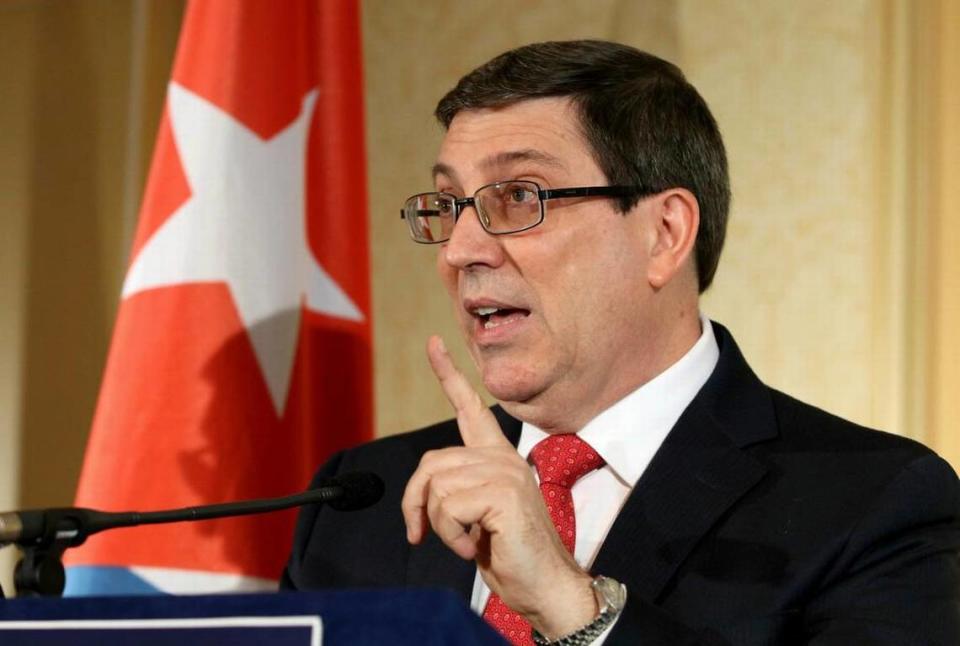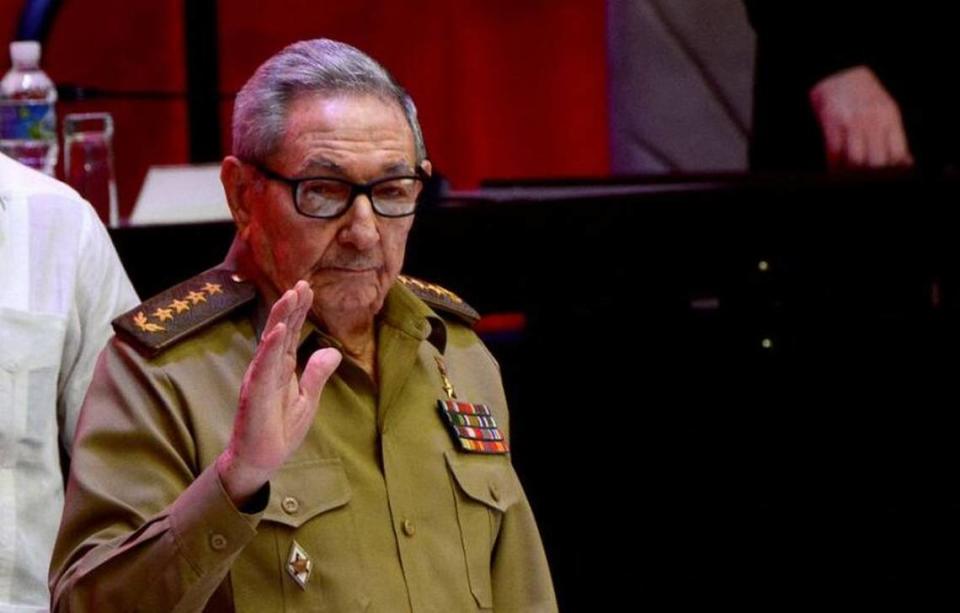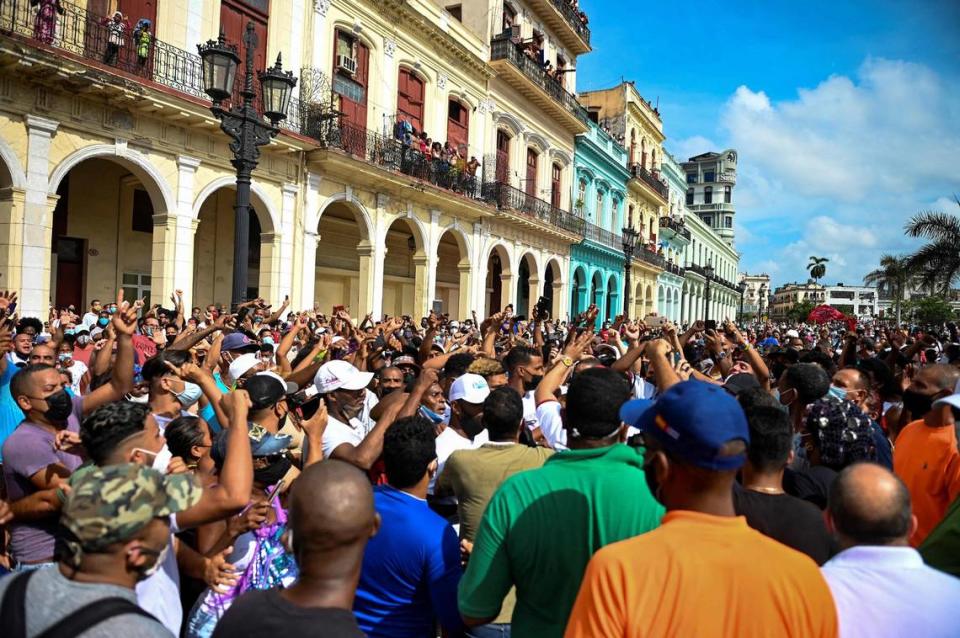Blaming U.S. for protests, Cuba official says actions could trigger exodus from the island
- Oops!Something went wrong.Please try again later.
Accusing the U.S. of masterminding and financing the massive protests in Cuba this week, the island’s foreign minister issued a veiled threat that American actions could trigger a new exodus of Cubans to the United States.
“I accuse the government of the United States of being directly involved and of having serious responsibility in the incidents that occurred on July 11 and I warn again that it will be responsible for the consequences that arise,” Foreign Minister Bruno Rodriguez said, adding the U.S. is risking the “incitement of irregular and disorderly migratory flows between the two countries.”
Appearing live on television and Cuban government websites, Rodriguez added: “I warn the U.S. government that their irresponsible behavior may have serious consequences that damage the national interest of both countries.”

Around the same time Rodriguez was speaking, U.S. Homeland Security Secretary Alejandro Mayorkas, himself Cuban American, warned Cubans not to attempt coming to the United States illegally by sea.
“Any migrant intercepted at sea, regardless of their nationality, will not be permitted to enter the United States,” Mayorkas said at a press conference.
In Havana, Rodriguez labeled the unprecedented protests throughout the island Sunday “small disturbances” that were the direct result of U.S. government “aggression” through a “political operation” in social media.
He also accused the Republican government of Florida of taking part and financing demonstrations. He did not provide evidence other than saying that a company linked to activists who promoted the hashtag #SOSCuba and others that were circulating on social media before the protests was registered in Florida. He also said the U.S. government was funding news websites that published lies about the Cuban government and the situation on the island to encourage regime change.
Rodriguez resorted to a PowerPoint presentation, and said activists funded by the U.S. government were promoting hashtags against his government using “untraceable bots” and were violating Twitter’s community policies. He also called president Biden’s statement of support of the Cuban people “cynical” and urged the administration to lift the 60-year-old embargo against the island.
The demonstrations led to the death of at least one protester, the Cuban government acknowledged Tuesday in a hint that the protests that began Sunday carried on into the next day. (The government has shut off internet service in large swaths of the island, making it difficult for Cubans to share social videos of protests since Sunday.)
Diubis Laurencio Tejeda, 36, died during “disturbances” on Monday in La Guinera, a neighborhood on the outskirts of Havana, Cuba’s Interior Ministry said. Videos posted on social media on Tuesday show images of protests reportedly taking place in Santa Clara, Cardenas and Camagüey.
Although the government has tried to minimize the impact of the demonstrations, they were deemed significant enough for Raúl Castro, the octogenarian leader who is still the ultimate authority in Cuba, to come out of retirement to attend an emergency meeting of the Communist Party’s Politburo.

The meeting, reported by the official Communist Party daily Granma, took place on Sunday, the day thousands of Cubans took to the streets demanding the “end of the dictatorship” in several cities, including Havana. It is unclear why Granma’s website waited till Monday to publish the information.
The paper repeated accusations by Cuba’s handpicked president, Miguel Díaz-Canel, that the U.S. was behind the protests. U.S. officials have dismissed those claims.
“During the meeting, provocations orchestrated by counterrevolutionary elements, organized and financed from the United States with destabilizing purposes, were analyzed,” Granma said.
The daily paper praised “the exemplary response of the people to the call of comrade Díaz-Canel to defend the Revolution in the streets, which allowed the defeat of the subversive actions.”
Castro’s presence in the meeting may be an indication that there are doubts that Díaz-Canel, whom Castro himself selected to succeed him at the top of the party and as president, can handle the crisis alone.
After the protests started in San Antonio de los Baños near Havana, Díaz-Canel visited the town in the hopes of calming the situation, in a gesture mimicking what the late Fidel Castro did when demonstrators took to the Malecon in 1994. But by Sunday afternoon, the protests had spread throughout the country. Díaz-Canel then appeared on television, seemingly agitated, and called on fellow communists to confront the demonstrators by any means necessary. Facing criticism, he tried to walk back his comments in a televised address on Monday, saying he didn’t call for violence but said the demonstrators “got what they deserve.”
He has been the target of the ire of demonstrators who have chanted his name along with a common Cuban expletive.
Despite Granma’s claims about the unrest being under control, several videos circulating on Monday evening show further confrontations with the police in at least two neighborhoods in Havana. In one of the videos reportedly taken in the crowded neighborhood of El Cerro, in the center of Havana, there are sounds of gunshots and people running and cursing Díaz-Canel.
The new videos show both the scale of the protest and the government reaction. The videos include images of an injured man, blood visibly pouring from his head, being treated by first respondents on the pavement. In another video, a man shows what seems to be a gunshot wound. In another, a woman tries to wipe blood from her face.
Other videos show police officers wearing riot gear, several police cars and trucks patrolling the streets, police officers beating back the crowds, and demonstrators throwing stones and forcing several police cars to back up to get away. Photos and videos also show people mobilized by the government holding sticks similar to baseball bats. Some appear very young and thin and wearing military boots, suggesting they might be fresh recruits in Cuba’s mandatory military service.
It’s unclear how many people have been arrested since Sunday’s rallies and how many are still detained. More than 50 members of the Movimiento San Isidro, a group of activist artists, are still in detention, the movement reported on its social media. One of the movement leaders, Luis Manuel Otero Alcántara, remains in Villa Marista, an Interior Ministry prison in Havana where political prisoners are kept, according to the movement’s Twitter account.

Father Castor José Alvarez, who in 2018 was part of a group of priests who wrote a letter to Raúl Castro asking for free elections in Cuba, was beaten and detained on Sunday, then released on Monday, the Ermita de la Caridad Catholic Church organization said on its Facebook page.
José Daniel Ferrer, the leader of the Patriotic Union of Cuba, the largest opposition organization, which is particularly strong in Santiago de Cuba, was arrested along with his older son when they were trying to join the protests on Sunday, his brother Luis Enrique Ferrer told the Herald.
“They told his wife they were at a police station in Versailles [Santiago de Cuba] and that they were being held indefinitely because they were in a state of war,” Ferrer said.
On Tuesday afternoon, police arrested a young YouTube activist who goes by the name Dina Stars just as she was being interviewed on a live TV show on Spain’s La Cuatro TV station. She had shared a video of a demonstration in Havana and images of pro-government counter-protesters armed with sticks.
“I make the government responsible for whatever happens to me,” she said, visibly shaken. “They’re forcing me to go with them.”
Meanwhile, Spanish Foreign Minister José Manuel Albares demanded the “immediate” release of independent journalist Camila Acosta, a Cuban who was arrested while trying to cover the demonstrations. She is a correspondent for the Spanish daily ABC.
“Spain defends the right to demonstrate freely and peacefully and asks the Cuban authorities to respect it. We defend human rights without conditions,” he tweeted Tuesday.
Several demonstrators shared their accounts of the protests on social media. Maykel Gonzalez Vivero, an independent journalist who runs the LGBTQ news website Tremenda Nota, was arrested “after the violent end of the demonstration” in Havana on Sunday, he tweeted. He was taken to a police station and released the following day.
“The protest was the largest in the history of the Cuban Revolution. I calculate, at first glance, more than 5 thousand people,” he wrote. “We marched from the monument to Máximo Gómez, in Old Havana, to the vicinity of the Plaza de la Revolución.”
“There were hundreds of special Minint [Interior Ministry] troops and many more para-police officers who attacked the protesters with batons. Some protesters threw stones at them. That’s when we were disbanded,” he continued. “I took refuge in a portal with dozens of people. Next to me, an older woman in her 60s was wiping the blood from her nose.”
Attempts to reach Vivero by phone and WhatsApp have been unsuccessful. Netblocks, a London-based organization tracking disruptions of internet service, confirmed “targeted restrictions” of communication platforms such as WhatsApp, Facebook, Instagram and Telegram by the state telecommunication monopoly ETECSA since Monday.
The U.S. Coast Guard issued a statement urging Cubans not to take to the sea in an effort to reach the United States. It also warned that taking a vessel to the island without authorization is illegal, after reports of people in Miami gathering provisions in the hopes of going to Cuba.
“The Coast Guard and our federal partners maintain persistent and vigilant airborne and surface patrols in the Caribbean, including the Florida straits to ensure safety of life at sea for all mariners,” the statement said. “Please don’t take to the sea.”
Miami Herald staff writer Adriana Brasileiro contributed to this report.

